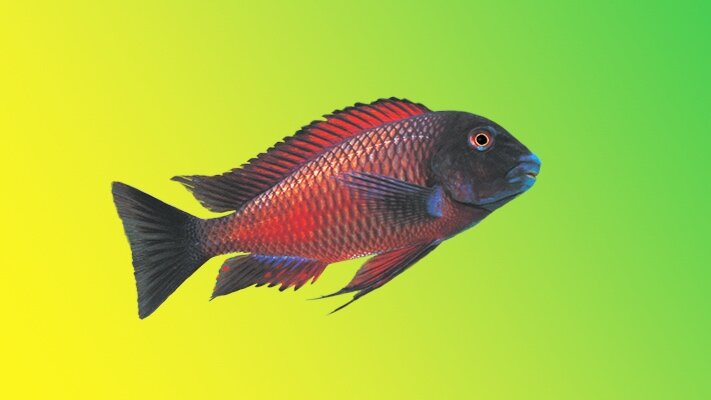Carbohydrates & Fats in Aquariums
When it comes to carbohydrates and fats in the keeping aquarium fish healthy, we have to take a look at the life of the fish in an enclosed aquarium environment, as well as the way in which tropical fish utilize these building blocks of life…
THE ROLE OF CARBOHYDRATES
Tropical fish don’t use carbohydrates efficiently. Some is nevertheless included in pellet foods because without some grains, pellets (and flakes) wouldn’t hold together. In quality feeds, the use of carbohydrates is the minimum amount needed as a binding agent.
However, some foods may use grains as a source of inexpensive energy and add a high amount to the formula. This is better for the profit margin of the manufacturer than for your aquarium companions. Grains have some place in aquarium foods beyond serving as binders. They can help synthesize lipids and proteins. However, too much ends up stored as fat. It also increases the amount of undigested waste expelled by the fish, leading to pollution of your aquarium water.
Grain by-products are also very difficult to digest by many species and can cause gastrointestinal issues due to poor digestibility and absorption rates. This can, in turn, lead to bloat due to pathogenic bacteria multiplying within the intestinal tract (as quickly as doubling their population every 20 minutes). In most cases, this condition is both extremely contagious and fatal.
LIPIDS: FINDING THE RIGHT BALANCE
Lipids (aka “fats”) are high-energy nutrients supplying about twice the energy as proteins and carbohydrates. In aquarium diets this is Omega-6 and Omega-3. They typically should comprise about 5–10% of a tropical fish’s diet. Lipids also supply essential fatty acids that serve as transport for fat-soluble vitamins.
Yet finding this correct fat balance in a fish diet is essential. Fatty infiltration of the liver has been designated as one of the most common metabolic disturbances and frequent causes of death in aquarium fish. The connection between excessive lipids and fatty liver disease has been common knowledge in the aquaculture industry for years. The Department of Fisheries and Aquatic Sciences at the University of Florida has confirmed this is a study involving African cichlids as test subjects.
We believe 5% fat isn’t enough to maintain the typical energy expenditure in an aquarium for any species of fish. Without sufficient lipid content, they will end up tapping into bodily protein to compensate. More than 10% is more lipid-based energy than warm water fish use in a captive environment and runs the risk of fatty deposits in or around vital organs such as the liver. There’s a big difference between a fat fish and a muscular, toned fish. Balance that takes into account typical activity levels in an aquarium is key.
Increasing dietary fat in a fish food reduces costs for manufacturers by lowering the requirements for expensive protein sources like krill or whole fish in the formula. However, this is at the expense of your fish’s health.
Foods designed for commercial food fish are typically higher in fats than recommended for tropical fish. This makes sense if you consider that for food fish production, the feed must be cheap, and the goal is to promote rapid growth in fish with a limited lifespan before harvest. However, for our tropical companions, our goal is as long a lifespan as possible.
In the next article, we’ll be talking about vitamins and minerals and their role in fish nutrition and feeding — as well as trace elements. Plus, we’ll be covering the controversial topic of copper in fish nutrition.
BIBLIOGRAPHY & RECOMMENDED READING
Royes, J.B., Murie, D.J., Francis-Floyd, R. 2005. Optimum dietary protein level for growth and protein efficiency without hepatocyte changes in juvenile African cichlids, Psuedotropheus socolofi. North American Journal of Aquaculture 67:102-110.
Royes, J.A., Murie, D.J., Francis-Floyd, R. 2006. Effects of varying dietary protein and lipid levels on growth performance and hepatocye changes in juvenile African cichlids. Journal of the World Aquaculture Society 37(1):48-59. National Research Council Nutrient Requirements of Fish 1993 National Academy Press Washington, DC.
Davis B.H. Carotenoid metabolism in animals: A biochemist’s view. 1985. Pure Appl. Chem. 57:679-684.
Goodwin T.W. The Biochemistry of the Carotenoids, 2nd ed., Chapman and Hall, London, 1984, pp. 64-96.
Matsuno T. and S. Hirao. Marine Carotenoids, In “Marine Biogenic Lipids, Fats, and Oils” (ed. by R. G. Ackman), Vol. 1, CRC Press, Boca Raton, Florida. 1989. pp. 251-388.
Miki M., K. Yamaguchi, and S. Konosu. 1986. Carotenoid composition of Spirulina maxima. Nippon Suisan Gakkaishi. 52:1225-1227.
Composition carotenoid pigments in the Antarctic Krill Euphasia superba. Nippon Suisan Gakkaishi.49:1411-1415.
Jauncey, K. 1982. The effects of varying dietary protein level on the growth, food conversion, protein utilization and body composition of juvenile tilapias (Sarotherodon mossanbicus). Aquaculture, 27: 43-54.
Vinogradov, A. P., 1953. The elementary chemical composition of marine organisms (Efron and Setlow, translators), Yale University Press, New Haven, 463-566.

